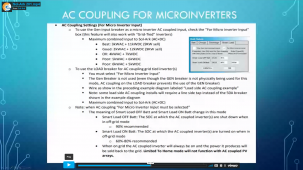RayofSunshine
New Member
- Joined
- Sep 21, 2021
- Messages
- 98
And if you think micros might be for you because:Hmmm, maybe have to rethink my setup, was gonna do all DC to DC, but might mix in some micro inverters. I doubt I’d ever push the Sol-Ark with just the DC setup, but something to think about.
1. You might now or in the future have PV panel capacity well over 15 kW, and/or
2. You don’t plan on using the gen input for a backup generator (remember that you can add a whole house backup generator with a separate ATS wired into the grid input), and/or
3. You have some shading and/or orientation issues, and/or
4.You need or want panel RSD capabilities
Then you might want to check out Sol-Ark’s new micros. From the comparison charts shown in Tom Brennan’s Alt-E conference webinar YouTube videos, they look price competitive with Enphase and Tigo (for the 4 panel M2000 model). As we now know, you just have to ignore all the talk about “doubling your output by adding only micros”.
I would consider AC coupling just enough PV panel wattage (real world wattage for your particular location and installation) to cover your daytime AC loads. Then DC couple the rest of your panels to the MPPTs to charge the (DC coupled) batteries more efficiently. Remember the answers to all those specific questions I asked of Sol-Ark: if the AC loads are met and there is extra AC coupled PV input, the inverter will invert it back to DC to charge the batteries; and if the batteries are charged and there is extra DC input, the inverter will invert the excess and send it to the loads.



